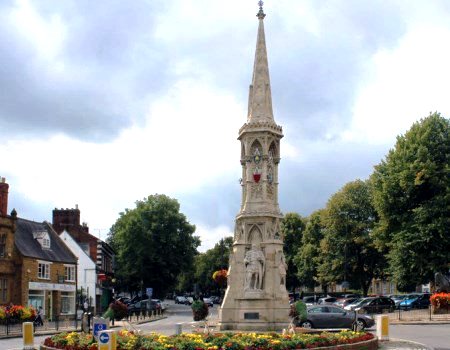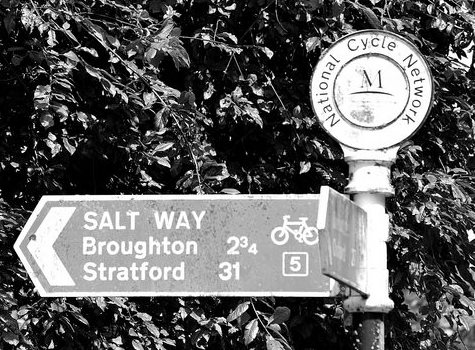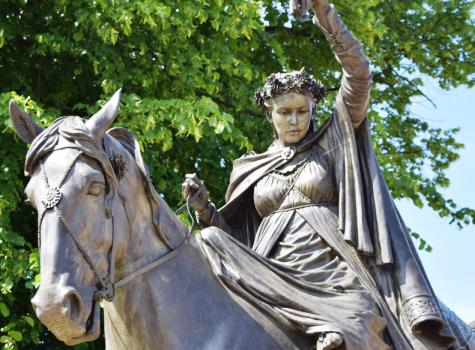Tell someone you live in Banbury & they’ll start reciting:
Ride a cock-horse to Banbury Cross,
To see a fine lady upon a white horse;
Rings on her fingers and bells on her toes,
And she shall have music wherever she goes.
Considering how well-known that little ditty is you’d think we’d know a lot about its origins but we don’t. We don’t know:
- which cross they are talking about,
- who is riding to that cross,
- how many versions of the rhyme there are,
- when the rhyme first showed up,
- what they meant by cock-horse,
- how the frog fits in.
There are quite likely people who have studied this whole thing in depth and can talk for hours about the origins and meaning of it all. To normal, everyday people (like me and I suspect, you) the information seems inconsistent and like many questions involving oral traditions of this type -definitive answers are lost in time. So what do we have? Thanks to those people who did all the studying – we have informed guesses. So let’s get to guessing.
THE CROSS
The age of the rhyme itself is open to some questions but from a historical fashionista point of view “bells on her toes” hints at medieval origins. If we assume that is the case, there were three crosses in Banbury at the time, none of which were called The Banbury Cross. There was the High cross (also known as the Market Cross since that is where it stood), the Bread Cross and the White Cross.

Most people agree “Banbury Cross” refers to the High Cross as it was the most centrally located. The High Cross was destroyed in a frenzy of puritan zeal in 1600 (an incident that inspired scenes in Ben Jonson’s Bartholomew Fair) and the other two crosses met similar fates. But Banbury isn’t without its cross – it’s just not in the same place. Why the Victorians decided to put the new cross in a whole new place I cannot say but it seems peevish to complain. At least they put up a replacement cross which is more than can be said for those who destroyed the first one who were ordered to do so but never did.
So, thanks Victorians, even if you made some odd choices – and not just about the location. Apparently some of them weren’t sure a cross was a good idea and thought a drinking fountain would be more useful. Rather than settle the matter one way or another, they fitted the cross with a water tap (which has now been removed). The original position of the High Cross is marked by a plaque in the market square.
There is a school of thought that says Banbury Cross doesn’t refer to an actual Cross at all but rather a crossroads. The basis for this is that Banbury sits at the point where two very important and ancient roads – The Salt Way and the Jurassic Way – cross. Location is everything. It’s true now and it was true then.

So – we kind of, sort of, think we know which cross is the Banbury Cross but then there’s this woman.
THE LADY
Surely, you say to yourself, we must know who she is – I mean, how many women with bells on their toes were roaming the countryside on a white horse? Well, I can’t speak to the white horse business but back in the day, it was all the rage to have bells on your shoes so that doesn’t really help narrow down the field.
The truth is – we don’t know who the Fine Lady was and what’s more, the rhyme didn’t ALWAYS refer to “a fine lady.” There are early versions of the ditty that mention an “old lady” – the fine (or sometimes Fyne) lady coming in later. Sometimes it is even spelled ‘Fiennes’ lady (referring to Celia Fiennes, family connection of the Fiennes of Banbury and Broughton Castles). Maybe someone was trying to butter up the Fiennes but Celia was most definitely NOT the lady originally referred to. We know this she wasn’t born until 62 years after the cross had been destroyed. That’s the thing about the Fiennes family though. They are threaded through Banbury history. Much like location, they are here now and they were here then. They are a whole story in themselves. But another time. Let’s get back to the “Lady.”

The last and most unlikely theory about the identity of the Fine Lady is that she was Lady Godiva – but that’s even more of a stretch than Celia since no one can find a connection to Banbury and that well known equestrian.
THE HORSE
Speaking of things equestrian – let’s turn our attention to the Cock-horse. “Ride a cock-horse to Banbury Cross”, we are told. Which I’m sure we’d be happy to do if we knew exactly what this potentially medieval poem meant. We know what it means NOW – it’s a child’s toy – but cock-horse meant several things before the 16th century, such as an extra horse added to a team to assist over rough terrain or to get a heavy load uphill. If the rhyme is really medieval, might cock-horse have meant “take the extra horse?” Of course, by the time the rhyme was being produced consistently, cock-horse meant a rocking horse or more often, a hobby horse. Banbury has wholly embraced the hobby horse option and holds an annual Hobby Horse Festival with many people dressing up as hobby horses or, in some cases, as the Fine Lady. There are also floral installations in the shape of Hobby Horses surrounding the current Banbury Cross.
THE FROG
Not ALL the questions I’ve got about the Fine Lady/ Banbury Cross are of ‘olde’ origin. Some are fairly recent. You see, there was a statue of the fine lady unveiled in 2005. She sits atop her handsome steed, looking toward the current Banbury Cross. She’s got flowers in her hair and – yes, indeed, bells on her toes. The observant visitor will also notice that just under the horse’s hoof, there sits a frog.
Now, wait – I know what you’re about to say. You’re going to say that there is no frog in the nursery rhyme. You’re right, there isn’t. There is no frog mentioned in the original rhyme, or indeed in any version of the rhyme – but there it sits, as a nearby plaque explains, representing ‘metamorphosis and the ongoing cycle of nature and community.’
What the plaque doesn’t explain (nor does anyone else) is what ‘metamorphosis and the ongoing cycle of nature and community’ has to do with the Fine Lady, the Banbury Cross or Banbury overall.
After much research, I posit that this might be a reference to the number of times Banbury has had to pick itself up and rebuild throughout its history. There was a large and devastating fire across a good part of central Banbury in 1628 that destroyed about a third of the houses in town. There was massive rebuilding and repair done after both sieges at Banbury Castle during the Civil War. The air raids of World War Two weren’t as destructive as the Germans had intended but damage was certainly done, yet Banbury did what Banbury always does – picked up the pieces, patched the holes and moved on.
So, while I can’t say any of this is DEFINITE – I think we can call them reasonable and informed guesses about the mysteries of the Banbury Cross and its rhyme. I feel much more informed every time I walk by the Lady. I hope you do too.
